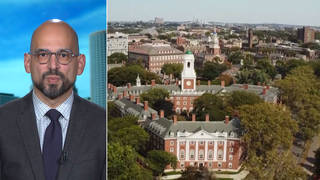
Guests
- Syed Iqbal Hasnainchair of the Glacier and Climate Change Commission established by the state government of Sikkim in India.
We look at the impact of climate change in the Himalayas region in Asia, where scientists are warning glaciers are receding faster than anywhere else in the world, with the potential to devastate over a billion people. The Himalayan glaciers have been described as the water towers of Asia, as they provide a key source of water to ten major Asian river systems. We speak to the prominent Indian scientist and glaciologist Syed Iqbal Hasnain. [includes rush transcript]
Transcript
AMY GOODMAN: We continue on the issue of climate change. Juan?
JUAN GONZALEZ: Well, we turn now to look at the impact of climate change in the Himalaya region in Asia, where scientists are warning melting glaciers could have a devastating impact on over a billion people.
The Himalayan glaciers have been described as the water towers of Asia, as they provide a key source of water to ten major Asian river systems spread across Afghanistan, Bangladesh, Bhutan, China, India, Burma, Nepal and Pakistan.
AMY GOODMAN: Scientists say the glaciers in the Himalayas are receding faster than anywhere else in the world. By the end of this century, 75 percent of the Himalayas glaciers could be gone.
We’re joined by the prominent Indian scientist and glaciologist Syed Iqbal Hasnain. He’s the chair of the Glacier and Climate Change Commission established by the state government of Sikkim in India. He spoke last night at the Asia Society at an event called “The Himalayan Glaciers and Asia’s Looming Water Crisis.”
We only have a few minutes, but can you lay out what this crisis is and what’s happening in the Himalayas?
SYED IQBAL HASNAIN: Thank you very much for having me on the show.
The whole crisis, as been mentioned about earlier, that two degree Celcius has already been exceeded; if you can word into the watts per meter-squared radiative energy, is about 20 percent. So this is a big dilemma for the policymakers, that how they are going to stop it, because we are already seeing that Copenhagen has already been a failed attempt, because there was no verifiable cut agreement on that. And the global — the whole world, I think, has to do something for it.
And as far as the Himalayan glacier is concerned, they are melting at a very accelerating rate, and not only in the Tibetan Plateau, because you have glaciers, you have permafrost. Permafrost is melting, and similarly the glaciers are melting. But they are huge in number, just like North and South Pole. So it take a while for them to melt. That’s why the water is increasing in all the river systems, whether it’s the Indus or the Brahmaputra. And in the years to come, that is going to decline. Then that will be a big catastrophe for the entire communities there, which are more than 1.5 to two billion people, which are directly dependant on these water resources coming from the Tibetan Plateau and the Great Himalayan ranges.
JUAN GONZALEZ: And how quickly do you see the receding of the glaciers?
SYED IQBAL HASNAIN: You know, there are some — you know, they have a different climatic setting in the Himalayan — across the Himalayan arc. So those who are on the eastern side, fed by the monsoonal rain during the summertime, they are receding much faster than on the western side they are coming during the wintertime. So we have a complex climatic system in the Himalaya, and the response time is different. But across the Himalaya, all glaciers are receding with different time lines.
AMY GOODMAN: Talk about the importance of the glaciers. You mentioned the rivers with the glacier and the permafrost melting. What you see in the next decades?
SYED IQBAL HASNAIN: You know, I see, as we have not done anything on to stop the greenhouse gases or the regional problem, we have the black carbon, which is also accelerating the melt in the region, because this black carbon impact is more on the Himalaya. So I see that more and more melt will be there. And then, after a certain time, now the discharge is going up, then the discharges will go down. And recent studies by the earth scientists already come — indicated that 151 percent of Himalayan snow and ice component is there in the Indus River, as compared to the rainfall, because rainfall is also decreasing in this region, because the climate — because the greenhouse gases and the black carbon impact. So, overall, we see a decline, and then there will be an issue from where these —- because the most important part of the glacier melt is not that how much water they are providing, but is the season, in which season they are providing, because they give the water to the downstream communities and to the agricultural ecosystem maintaining in the lean period, in the summertime.
AMY GOODMAN: What has to be done now?
SYED IQBAL HASNAIN: I think it is in a very important issue. The global community has to come together into the next Cancun and then decide about cuts -—
AMY GOODMAN: Cancun being the next climate change summit.
SYED IQBAL HASNAIN: Yeah, next climate change meeting.
AMY GOODMAN: December.
SYED IQBAL HASNAIN: And they have to be very serious about it. Simply with not talk that will do this, but has to come out with a certain cuts, globally and regionally. These countries, the South Asian countries, including China, has to cut down on the black carbon emission, which is coming from the diesel and from the biomass burning. So they have to change that, cooking stoves and things like that, over millions of people, to reduce the black carbon emissions and similarly put up the filters on their trucking, which is the huge problem in the Himalaya because of the army prisons of the China, India and Pakistan. And that somehow have to be reduced, and then we’ll see some changes occurring in the cryosphere of the South Asia.
AMY GOODMAN: Well, I want to thank you very much for being with us. Syed Iqbal Hasnain is the Indian scientist who studied the impact of climate change on glaciers, chair of the Glacier and Climate Change Commission established by the Sikkim government in India.













Media Options